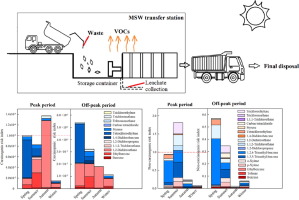Waste Management ( IF 8.1 ) Pub Date : 2020-03-29 , DOI: 10.1016/j.wasman.2020.03.031 Junwan Liu , Guodi Zheng

|
Volatile organic compounds (VOCs) are the main precursors of tropospheric ozone and secondary aerosol generation, posing a threat to human health and affecting the environmental climate. A large quantity of VOCs can be produced in the initial decomposition stage of municipal solid waste (MSW). In this study, the atmosphere in an MSW transfer station was monitored for one year. The emission characteristics of VOCs in different seasons and working hours were analyzed, and the ozone-formation potential of VOCs was calculated through the maximum incremental reaction method, and health risks posed by the VOCs in the MSW transfer station were assessed. The results showed that the highest concentration of VOCs appeared in spring and summer, accounting for 70.6% and 26.6% of total VOCs (TVOCs) in peak working periods, respectively. Oxygenated compounds and terpenes contributed most to ozone formation, accounting for 41.0% and 50.6% of total ozone formation, respectively. The carcinogenic risks were above the safe threshold, labeled “probable risks”. Tetrachloroethylene and 1,2-dichloroethane were the main contributors to carcinogenic risks. The mean non-carcinogenic risks were within the safe threshold in the MSW transfer station. From the perspective of protecting human health and ecological environmental safety, VOC control needs to be further strengthened in the transfer station.
中文翻译:

小型城市固体废物转运站排放的挥发性有机化合物:形成臭氧的潜力和健康风险评估
挥发性有机化合物(VOC)是对流层臭氧和二次气溶胶产生的主要前体,对人类健康构成威胁,并影响环境气候。在城市固体废物(MSW)的初始分解阶段会产生大量的VOC。在这项研究中,对城市固体垃圾中转站的大气进行了一年的监测。分析了不同季节和工作时间的挥发性有机化合物的排放特征,通过最大增量反应法计算了其挥发性有机物的臭氧形成潜势,并评估了挥发性有机化合物在城市固体垃圾中转站带来的健康风险。结果表明,在春季和夏季,挥发性有机化合物的浓度最高,分别在高峰时期分别占总挥发性有机化合物(TVOC)的70.6%和26.6%。含氧化合物和萜烯对臭氧形成的贡献最大,分别占总臭氧形成的41.0%和50.6%。致癌风险高于安全阈值,标记为“可能风险”。四氯乙烯和1,2-二氯乙烷是致癌风险的主要贡献者。在MSW转运站中,平均非致癌风险在安全阈值之内。从保护人类健康和生态环境安全的角度出发,需要进一步加强中转站的挥发性有机化合物控制。在MSW转运站中,平均非致癌风险在安全阈值之内。从保护人类健康和生态环境安全的角度出发,中转站的VOC控制有待进一步加强。在MSW转运站中,平均非致癌风险在安全阈值之内。从保护人类健康和生态环境安全的角度出发,需要进一步加强中转站的挥发性有机化合物控制。



























 京公网安备 11010802027423号
京公网安备 11010802027423号